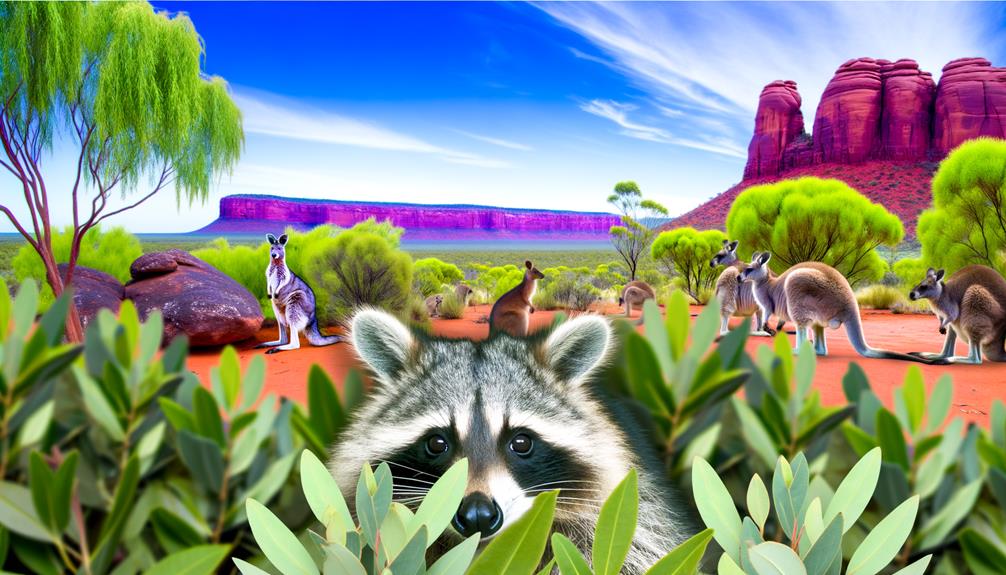How You Can Get to Recognize and Report Raccoons in Australia
Raccoons are not indigenous to Australia, hailing instead from North America. Stringent importation laws and thorough biosecurity measures effectively prevent their introduction and establishment in Australia.
Raccoons have shown significant ecological impacts in other countries where they become invasive. Australia's efforts to preserve its unique biodiversity, such as enforcing quarantine protocols and legislative actions, are essential in mitigating these risks.
Careful monitoring and public awareness campaigns further guarantee that non-native species like raccoons do not disrupt native ecosystems. To understand the complexities of these measures and their importance, you may explore the steps Australia takes to prevent ecological disruptions.

Key Takeaways
- Raccoons are not native to Australia and are not legally allowed to be imported due to stringent biosecurity laws.
- Australia's strict importation laws and biosecurity measures prevent the introduction of non-native species like raccoons.
- Raccoons pose a significant ecological threat to native Australian wildlife through competition, habitat disruption, and disease transmission.
- Public awareness and stringent border controls are crucial in preventing raccoons from entering and establishing populations in Australia.
- Import permits for adaptable species like raccoons are rarely granted to protect Australia's unique biodiversity.
Native Habitat of Raccoons
Although raccoons are native to North America, they are versatile creatures that can thrive in a variety of habitats ranging from forests to urban environments. Scientifically known as *Procyon lotor*, raccoons exhibit remarkable adaptability, making use of diverse resources within their surroundings.
In their natural forested habitats, they are often found near water sources such as rivers, lakes, and marshlands, utilizing these areas for foraging. Their diet is omnivorous, consisting of fruits, nuts, insects, small vertebrates, and aquatic organisms.
In urban settings, raccoons have adapted to human presence, frequently scavenging through garbage and finding shelter in attics and sewers. This adaptability is key to their survival and proliferation in varied environments, underscoring their ecological flexibility and resourcefulness.
Raccoons in Other Countries
Beyond their native range in North America, raccoons have been introduced to several other countries, often resulting in significant ecological impacts. In Europe, particularly Germany, raccoons have established sizeable populations after being introduced for fur farming and subsequently escaping.
These omnivorous mammals have adapted well, preying on native species and competing with local wildlife for resources. Japan also faces challenges with raccoon populations, introduced as pets and later released into the wild. This has led to damage to crops, historical structures, and disruptions to native ecosystems.
Their adaptability and lack of natural predators in these non-native regions contribute to their invasive status, underscoring the importance of stringent wildlife management and biosecurity measures in preventing further ecological imbalance.
Australian Wildlife Overview
Australia's wildlife is renowned for its unique biodiversity, characterized by a high degree of endemism among its flora and fauna. The continent's isolation has led to the evolution of species found nowhere else on Earth. Notable examples include marsupials such as kangaroos and koalas, as well as monotremes like the platypus and echidna. The diverse habitats range from arid deserts to lush rainforests, each supporting distinct ecological communities.
| Species | Notable Features |
|---|---|
| Kangaroo | Marsupial, strong hind legs for jumping |
| Koala | Marsupial, primarily arboreal, eucalyptus diet |
| Platypus | Monotreme, venomous spur, lays eggs |
| Echidna | Monotreme, spiny coat, insectivorous |
| Cassowary | Large flightless bird, known for agility |
This biodiversity underscores the importance of conservation efforts to protect these irreplaceable ecosystems.
Importation Laws in Australia
Stringent importation laws in Australia are meticulously designed to prevent the introduction of non-native species that could disrupt the country's fragile ecosystems. These laws, governed by the Department of Agriculture, Water and the Environment, are thorough and multifaceted. They require rigorous risk assessments and quarantine protocols to evaluate potential ecological impacts.
Import permits are rarely granted for species like raccoons, which are known for their adaptability and potential to become invasive. The legislative framework is bolstered by the Environment Protection and Biodiversity Conservation Act 1999, ensuring that only species with negligible risk factors are considered for importation.
These measures reflect Australia's commitment to preserving biodiversity and protecting native species from foreign threats.
Biosecurity Measures in Place
Australia's biosecurity measures are rigorously enforced through stringent import regulations aimed at preventing the introduction of non-native species such as raccoons. These measures include thorough quarantine protocols designed to guarantee any potential threats are identified and mitigated before entering the country.
The effectiveness of such protocols is continually assessed and updated to address emerging risks and enhance national biosecurity.
Import Regulations Enforcement
To prevent the introduction of non-native species like raccoons, Australian biosecurity measures include strict import regulations and rigorous enforcement protocols. These measures are meticulously designed to safeguard the nation's unique ecosystems.
Customs and Border Protection officers, equipped with advanced detection technologies, conduct thorough inspections at all entry points. This includes scrutinizing cargo, personal belongings, and even mail. Additionally, stringent documentation requirements mandate that all imports are declared and compliant with national standards. Non-compliance can lead to severe penalties, including hefty fines and confiscation.
Data-driven risk assessments are continually updated to address emerging threats, ensuring a dynamic and responsive regulatory framework. These concerted efforts aim to mitigate ecological disruptions and maintain Australia's biodiversity integrity for future generations.
Quarantine Protocols Effectiveness
Ensuring the effectiveness of quarantine protocols is paramount in Australia's biosecurity measures to prevent the entry and establishment of invasive species like raccoons.
Australia's stringent quarantine protocols include rigorous inspection procedures at all points of entry, strict import regulations, and continuous monitoring of high-risk areas. These measures are designed to detect and intercept potential threats before they can establish populations in the wild.
Detailed observations reveal that the implementation of these protocols has notably reduced the incidence of invasive species. Additionally, Australia employs advanced diagnostic technologies and well-trained personnel to enhance detection capabilities.
Potential Raccoon Sightings
Recent reports of raccoon sightings in Australia remain unverified and require further investigation to establish their authenticity.
Observers may have mistaken indigenous wildlife, such as possums, for raccoons due to similar physical characteristics.
Accurate identification is essential to determine whether these sightings represent an ecological concern or a case of mistaken identity.
Unverified Raccoon Reports
Several reports of raccoon sightings across various regions of Australia have emerged, though these accounts remain unverified by scientific authorities.
These reports, mainly from urban and suburban areas, describe raccoon-like behaviors such as nocturnal activity, dexterous manipulation of objects, and distinctive facial markings.
Despite these detailed observations, no physical evidence, such as photographic documentation or biological samples, has been presented to confirm the presence of raccoons.
Expert analysis suggests that thorough investigations are required to validate these claims.
The absence of concrete proof makes it challenging to ascertain the accuracy of these sightings, necessitating further scrutiny to rule out potential misidentifications or other factors.
Consequently, raccoon presence in Australia remains speculative at this juncture.
Mistaken Animal Identity
In examining the potential for mistaken identity in raccoon sightings, it is important to take into account the presence of native Australian species that exhibit similar physical and behavioral characteristics. Several animals could be confused with raccoons due to their nocturnal habits and distinct markings.
Notable examples include:
- Common Brushtail Possum: Exhibits a bushy tail and nocturnal behavior.
- Bandicoot: Small, nocturnal marsupial with a pointed snout.
- Ringtail Possum: Characterized by its curled tail and tree-dwelling habits.
- Quokka: Small marsupial with a rounded face and nocturnal activity.
- Spotted-tailed Quoll: Carnivorous marsupial with a spotted coat and nocturnal tendencies.
Accurate identification is essential to prevent misconceptions about raccoon presence in Australia.
Ecological Impact of Raccoons
The introduction of raccoons to Australia has significant ecological implications, particularly due to their opportunistic feeding habits and adaptability to diverse environments.
Raccoons are known for their omnivorous diet, which allows them to exploit a wide range of food sources, from insects and small vertebrates to fruits and human refuse. This dietary flexibility can lead to the disruption of local food webs and the depletion of critical resources for native species.
Additionally, raccoons are highly adaptable, thriving in urban, suburban, and rural settings. Their presence can alter habitat structures and ecological processes, such as soil composition and plant regeneration. Such changes may undermine ecosystem stability and biodiversity, necessitating proactive measures to mitigate their potential impact.
Competition With Native Species
Raccoons pose a significant threat to native Australian species through direct competition for food, shelter, and other critical resources. Their presence can lead to significant ecological disruptions.
Observations highlight several areas of concern:
- Food Resources: Raccoons consume a wide variety of foods, potentially depleting resources essential for native species.
- Shelter: They often occupy burrows and nests, displacing indigenous wildlife.
- Breeding Sites: Competition for breeding sites can reduce reproductive success in native species.
- Predation: Raccoons may prey on smaller native animals, further destabilizing ecosystems.
- Adaptability: Their high adaptability allows them to thrive in diverse environments, exacerbating competitive pressures.
Addressing these impacts requires targeted management strategies to preserve Australia's unique biodiversity and support ecological balance.
Disease Transmission Risks
The introduction of raccoons into Australia poses significant disease transmission risks, particularly regarding rabies and various parasites.
Raccoons are known carriers of the rabies virus, which could have severe public health implications were it to be introduced into the Australian ecosystem.
Additionally, these animals host a variety of parasites that could affect both human health and native wildlife populations.
Rabies and Raccoons
Understanding the potential for rabies transmission from raccoons is significant for evaluating public health risks in Australia. Although Australia is currently rabies-free, the introduction of raccoons could potentially alter this status.
Raccoons are known carriers of the rabies virus, which has serious implications for public health.
Key points to keep in mind include:
- Transmission Pathways: Rabies is primarily transmitted through bites or saliva.
- Incubation Period: The virus can incubate for weeks to months before symptoms appear.
- Symptoms in Animals: Infected raccoons may exhibit aggression, paralysis, or disorientation.
- Human Impact: Rabies is almost always fatal once symptoms manifest in humans.
- Preventive Measures: Vaccination of pets and public awareness are critical.
Understanding these factors aids in crafting effective prevention strategies.
Parasites and Health Concerns
Many parasites harbored by raccoons pose significant health concerns in Australia. Baylisascaris procyonis, a roundworm commonly found in raccoons, is particularly alarming due to its zoonotic potential, causing severe neurological damage in humans.
Moreover, raccoons can carry ticks that transmit Lyme disease, posing additional public health risks. The introduction of these parasites could lead to ecological imbalances, threatening local species unaccustomed to such pathogens.
Proactive measures, including stringent biosecurity protocols and public awareness campaigns, are essential to mitigate these risks. Understanding the parasitic threats associated with raccoons is vital for safeguarding Australia's unique ecosystems and public health.
Public Awareness Campaigns
In response to the growing raccoon population in Australia, public awareness campaigns have been initiated to educate residents about the ecological impact and necessary preventive measures. These campaigns aim to foster community involvement and provide practical guidelines to mitigate the adverse effects of raccoons on local ecosystems.
Key focus areas include:
- Identifying raccoon presence: Educating residents on recognizing signs of raccoon activity.
- Waste management: Advising on securing trash to prevent raccoon foraging.
- Habitat modification: Recommending changes to landscaping that deter raccoons from nesting.
- Reporting sightings: Encouraging prompt reporting of raccoon sightings to authorities.
- Wildlife coexistence: Promoting responsible interactions with wildlife to minimize conflicts.
Case Studies of Invasive Species
Examining various case studies of invasive species provides critical insights into the ecological, economic, and social impacts these organisms can have on their new environments.
For instance, the introduction of the cane toad (Rhinella marina) in Australia has resulted in substantial disruptions to native ecosystems, predation of local fauna, and poisoning of predators.
Similarly, the European rabbit (Oryctolagus cuniculus) has caused severe soil erosion and vegetation loss, adversely affecting agricultural productivity.
The spread of feral cats (Felis catus) has led to the decline of numerous native species through predation.
These case studies underscore the multifaceted challenges posed by invasive species, emphasizing the importance of vigilance and rapid response to prevent significant ecological and economic consequences.
Future Prevention Strategies
Given the significant ecological and economic impacts demonstrated by these invasive species, developing effective future prevention strategies is crucial to mitigate further disruptions. To guarantee Australia's ecosystems remain resilient, several key measures must be considered:
- Enhanced Border Controls: Strengthening biosecurity to prevent raccoons from entering the country.
- Public Awareness Campaigns: Educating the community on the risks and identification of invasive species.
- Rapid Response Teams: Establishing specialized units to quickly address any new sightings or infestations.
- Legislative Action: Enforcing stringent laws and penalties for illegal wildlife trade.
- Research and Monitoring: Investing in continuous research to understand potential threats and track emerging patterns.
These strategies aim to protect Australia's unique biodiversity and support its ecological integrity.
Conclusion
To sum up, while raccoons are not native to Australia, stringent importation laws and robust biosecurity measures have to date kept these potential invaders at bay. The risks of disease transmission and ecological disruption underscore the importance of maintaining these safeguards.
Public awareness campaigns and case studies of other invasive species illustrate the potential consequences of lax prevention efforts. Future strategies must continue to prioritize vigilance and proactive measures to preserve Australia's unique biodiversity.






